The History of X-Rays in Dundee
"You can see other people's bones with the naked eye.....On the revolting indecency of this there is no need to dwell."
- London Pall Mall Gazette 1896
The Discovery
X-rays were discovered by Wilhelm Conrad Rontgen in November 1895. They are generated when a stream of electrons from the cathode of an evacuated electrical discharge tube strikes a target inside the tube. An early X-ray tube used at Dundee Royal Infirmary during the late 1890s can be seen here. The simplest tubes were Jackson-focused tubes made during 1896 and 1897. Later improvements involved introducing gas to the tubes, to produce more electrons, as in the Muller tube. Variations on this theme continued until 1913, when the hot cathode tube was designed.

Jackson-focused X-Ray Tube used at DRI c.1897
Early Experiments in Glasgow
Lord Blythswood (Sir Archibald Douglas Campbell, 1835-1908) was a "gentleman-physicist" in the days when members of the aristocracy could finance and follow their own scientific interests. He was a close friend of Lord Kelvin (1824-1907) and experimented in his own laboratory at his house in Renfrew near Glasgow. Three to four years before Rontgen's discovery, Lord Blythswood built a powerful Wimshurst machine which generated "torrents of large sparks" and with this he managed to obtain photographs through opaque substances, thus almost discovering X-rays.
'Longitudinal Vibrations Of The Luminiferous Ether'
Dr J T Bottomley of University Gardens, Glasgow wrote to Nature on 23rd January 1896 to say that Lord Kelvin (Professor of Natural Philosophy at Glasgow University from 1846 to 1899) had suggested the possibility of the existence of such "waves" in his 1884 Baltimore Lectures.
Discharge Tubes
The next step was to improve the discharge tubes. The Muller tubes contained gas which ionised to produce more electrons. Variations on this theme continued until 1913, when William David Coolidge (1873-1975) designed his hot cathode high vacuum tube, which stabilised the current and made control of the X-rays easier. The Coolidge tube meant that X-rays could be more widely used The Philips-Metalix tube based on Coolidge's principle, but encased in metal, was developed 1915.
The Coolidge Tube
In 1913 William David Coolidge designed a hot cathode high vacuum electrical discharge tube, which stabilised the current and made control of the X-rays easier. This meant that X-rays could be more widely used.
The Philips Metalix Tube
This tube was developed in 1915 and was based on Coolidge's design, but encased in metal for protection.
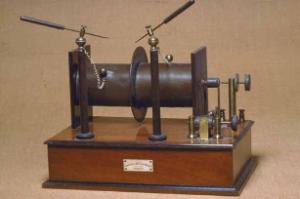
Induction coil, c.1890
Modern X-Ray Tube
Current tubes are now recycled by the manufacturers to save costs. The name 'Coolidge' is stamped on the tube, as the design is still based on his principle.
Induction Coil
An induction coil produced sparks of electricity and was used to supply electricity to the X-ray discharge tube, to produce the cathode rays (stream of electrons) inside the early X-ray tubes.
Wolff String Electrometer
Electrometers and electroscopes were used to measure or detect electrical charge and could be adapted to measure the dose of X-rays. For example, an electroscope would discharge in the presence of X-rays.
The Wolff string electrometer shown here estimated doses by the amount of movement in a conducting fibre or 'string', viewed though a quadrant scale on the eyepiece.
-300x285.jpg)
Wolff String Electrometer
X-Ray Investigations in Dundee
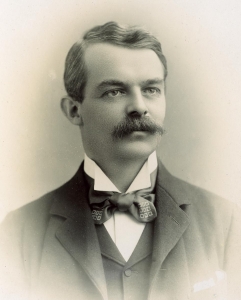
Prof E Waymouth Reid(Archive Services)
The Reid & Kuenen Collaboration
Edward Waymouth Reid (1862-1948) was born in Canterbury and graduated from Cambridge with a Natural Sciences degree in 1883; he gained his medical degree from St Bartholomew's, London in 1885. His early and continuing interests were in the electrical reactions of living tissues. In 1889 he was appointed Professor of Physiology at Dundee where he remained for 47 years. His research on X-rays only spanned a few years and did not survive the departure of Professor Kuenen, who made his own focus tubes for the X-ray studies.
Johannes Petrus Kuenen (1866-1922) started his study at Leiden in 1884. In 1895 he was appointed to the Chair of Physics in Dundee which he held until 1906. He is best known for his work on material state (gas, solid and liquid) equilibra that led to such work as the liquidification and solidification of Helium.
Waymouth Reid's own accounts of their collaboration make amusing reading:
"Passage of the rays for an hour through the head of a laboratory boy of medium intelligence did not in my hands cause deterioration or improvement thereof." Scot.Med.Surg.J. 1897
In 1897, Waymouth Reid subjected himself to 4 exposures of 20 to 90 minutes each in 4 days, which resulted in severe dermatitis and loss of hair for a prolonged period, with effects on his chest, facing the rays, and his back. His own description follows:
"Professor Kuenen, who in those days himself made all the college vacuum tubes, was my colleague in the sport. In his attempts to get a picture of a fountain pen in the pocket of my waistcoat worn front to back, he succeeded in damaging a good square foot of the varnish of my casing, though luckily the insulation of my field coils held out, and I can still command enough amperes to electrolyse a lobster mayonnaise.
"The early X-rays shadow pictures were a real delight. We groped for swallowed teeth within the entrails, of criminals supplied by the Bell Street authorities, and located bullets within the skulls of living men. The very idea of transparency in what we had always considered opaque was a stimulants to a photographer."
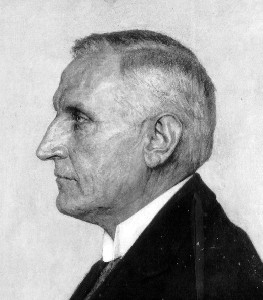
Prof J P Kuenen

Dr G A Pirie
George Alexander Pirie
George A Pirie was born on 19th August 1863 and became one of the early pioneers in the application of X-rays to clinical medicine. His family had a long association with Dundee Royal Infirmary. His father, Dr George Clark Pirie, was a physician there from 1862 to 1881 and was a cousin of Dr David Greig, one of the founders of the Forfarshire Medical Association. Dr William Lindsay Kinnear and Dr John Kinnear of the Dermatology department were nephews.
Dr Pirie graduated with an MA from St Andrews and was a fluent Greek scholar. He obtained an MBCM with first class honours from Edinburgh in 1886 and his MD in 1890. He began his investigations on X-rays at DRI in 1896, and continued his work there till 1925, when he was forced to retire due to ill-health, brought about by his long exposure to X-rays. He died in October 1929.
Watch a film about Pirie and X-Rays in Dundee
Early Fluoroscope
The cryptoscope or fluoroscope shown here was used in early days to test the quality of X-rays. Investigators used to hold their hand between the X-ray tube and the fluorescent screen on the cryptoscope to check how sharp and clear the image was. Dr Pirie at DRI obtained very clear X-ray images, as seen in his publications. Unfortunately, a price had to be paid, and many early investigators like Dr Pirie, developed tumours on their hands and fingers.
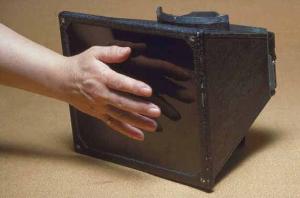
Fluoroscope
Tumours caused by X-Rays
In 1905, after 10 years of exposure to X-rays, Dr Pirie began to experience "trouble" in his hands. He developed the characteristic tumours and eventually lost both his hands. He had already lost his right hand, and the thumb and part of the fifth finger of his right hand when this amputation took place. His eyesight also began to fail. In 1926, when he was no longer able to continue working, he was awarded a Civil List pension and a Carnegie Hero Trust medal and pension. Dundee citizens also presented him with an award of £1120 raised by subscription, in grateful recognition of his unique services.
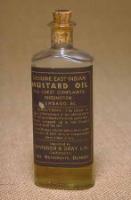

Mustard Oil and Protective Goggles used by Dr Pirie
Mustard Oil
This oil was used by Dr Pirie when his hands "began to give me trouble". He said "The skin cracked open, and it amused my comrades to see going about with sticking plaster all over them. Sometimes I would waken at night and find them tingling like fire. I was urged to give up the X-ray work and merely superintend, but I could never bring myself to cause others to take a risk that I would not take myself .... I was told that nothing could be done ... I like to draw a veil over these days."
Early X-Ray Protection
The glass and lead-lined goggles shown above were used by Dr Pirie to protect himself, once the danger of X-ray exposure was realised. Unfortunately they were too late to prevent him losing one eye altogether and most of the sight from the other.
The New X-Ray Room in 1925
When Dr Pirie received his awards in 1926 he spoke of his early experiments in the use of X-rays and of the improvements which had taken place since 1896. He mentioned that DRI now had "a splendid suite of rooms perfectly equipped with apparatus which worked accurately and swiftly." The tubes were encased, so that the operator could manipulate them.
The Hamburg Memorial
In 1936 a memorial was erected in Hamburg to the early pioneers of X-rays who suffered radiation injury or lost their lives due to their work. The name of G A Pirie, Dundee can be seen carved into the stone at the beginning of the 5th row from the foot. Of the original 169 names from 15 nations, 14 are from Britain. The other Scottish names are William Ironside Bruce from Aberdeen, William Hope Fowler, JWL Spence and Dawson Turner, all from Edinburgh, and James Riddell from Glasgow. The remaining British names are Reginald Blackall, Barry Blacken, John Hall-Edwards, Cecil Lyster, Stanley Melville, Hugh Walsham, John Chisholm Williams and Ernest Wilson.
The citation reads:
THEY WERE HEROIC PIONEERS FOR A SAFE AND SUCCESSFUL APPLICATION OF X-RAYS TO MEDICINE. THE FAME OF THEIR DEEDS IS IMMORTAL.
The Development of Radium Therapy
Stimulated by the interest in X-rays, Antoine Henri Becquerel (1852-1908) discovered natural radioactivity in March 1896. Subsequently, the Curies discovered radium in December 1898. Therapeutic applications began to be explored. Radium was extracted from pitchblende ore obtained in Bohemia until 1921. From then on the main source became the mines of Haut Katanga in the Belgian Congo. Belgium thus became the premier radium producing country.
All samples of radium had to be certified against known standards. In the first half of this century there were three radium standards, the earliest radium bromide from Austrian pitchblende and the others radium sulphate from Colorado country.
Cardiac Catheterisation
This technique was first investigated around 1860 by Chauveau and Marey in France, using horses who happily munched hay during the procedure. The aim was to measure pressures inside the ventricles of the heart. Because of the growing awareness about bacterial contamination, the procedure was not performed in human subjects until 1929, when Forssman experimented on himself. Improvements in X-ray technology led to the possibility of clinical use in 1941. Kenneth Lowe introduced the method in Dundee in the early 1950s, having seen the technique used in London after the war. The procedure not only allows investigation of pressures within the heart, it can also be used to deliver drugs to precise areas of the heart.
Originally created as part of the Made to Measure exhibition